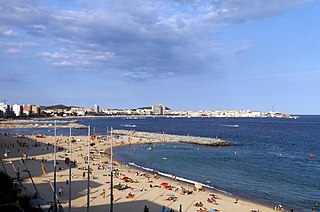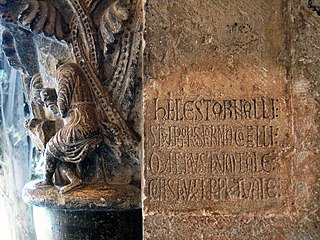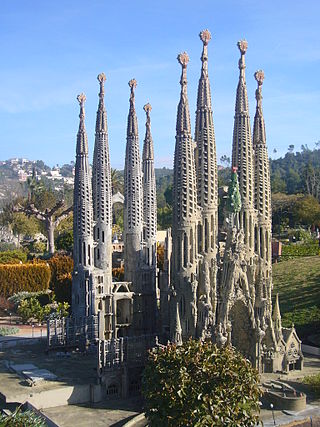
Tortosa is the capital of the comarca of Baix Ebre, in Catalonia, Spain.

Palamós is a town and municipality in the Mediterranean Costa Brava, located in the comarca of Baix Empordà, in the province of Girona, Catalonia, Spain. Palamós is located at the northern end of a large bay. The town is by-passed by the C31 which connects the coastal towns of the central Costa Brava with Girona. Palafrugell lies 8.5 kilometres (5.3 mi) to the north and Castell-Platja d'Aro 7 kilometres (4.3 mi) to the south.

Vic is the capital of the comarca of Osona, in the province of Barcelona, Catalonia, Spain. Vic is located 69 km (43 mi) from Barcelona and 60 km (37 mi) from Girona.

The Senyera is a vexillological symbol based on the coat of arms of the Crown of Aragon, which consists of four red stripes on a yellow field. This coat of arms, often called bars of Aragon, or simply "the four bars", historically represented the King of the Crown of Aragon.

The Crown of Aragon was a composite monarchy ruled by one king, originated by the dynastic union of the Kingdom of Aragon and the County of Barcelona and ended as a consequence of the War of the Spanish Succession. At the height of its power in the 14th and 15th centuries, the Crown of Aragon was a thalassocracy controlling a large portion of present-day eastern Spain, parts of what is now southern France, and a Mediterranean empire which included the Balearic Islands, Sicily, Corsica, Sardinia, Malta, Southern Italy, and parts of Greece.
Basilica of St. Mary may refer to:

Manresa is the capital of Bages county, located in the central region of Catalonia, Spain.

Oliba was the count of Berga and Ripoll (988–1002), and later abbot of the monasteries of Santa Maria de Ripoll and Sant Miquel de Cuixà (1008–1046) and the bishop of Vic (1018–1046). He is considered one of the spiritual founders of Catalonia and perhaps the most important prelate of his age in the Iberian Peninsula. Oliba was a great writer and from his scriptorium at Ripoll flowed a ceaseless stream of works which are enlightening about his world. Most important are the Arabic manuscripts he translated into Latin for the benefit of 11th century and later scholars.

Santa Maria del Mar is a church in the Ribera district of Barcelona, Catalonia, Spain, built between 1329 and 1383 at the height of Principality of Catalonia's maritime and mercantile preeminence. It is an outstanding example of Catalan Gothic, with a purity and unity of style that is very unusual in large medieval buildings.

Father Antoni Maria Alcover i Sureda, also known as Mossèn Alcover was a modernist Majorcan writer, who wrote on a wide range of subjects including the Catholic Church, folklore and linguistics. He is chiefly associated with efforts to revive interest in the Catalan language and its dialects. Among his works was a Catalan-Valencian-Balearic dictionary.
Ramon d'Abella was a Catalan military leader and royal councillor under John I and Martin of the Crown of Aragon.

Berenguer de Palou II was bishop of Barcelona from 1212 to 1241. He was a major supporter of James I of Aragon.

The Collegiate Basilica of Santa Maria, also known as La Seu, is a Romanesque-Gothic church in Manresa, Catalonia, north of Spain.

Arnau Cadell was a 12th–13th-century Catalan sculptor. He is best known for creating the cloister of the monastery of Sant Cugat.

Catalunya en Miniatura is a miniature park inaugurated in 1983 in Torrelles de Llobregat, 17 km (11 mi) from Barcelona. The park is 60,000 m2 (650,000 sq ft), 35,000 m2 (380,000 sq ft) of them devoted to the scale models, it is one of the largest miniature parks in the world, and the largest of the 14 miniature building exhibitions present in Europe. It displays 147 models of palaces, churches, bridges and other buildings from Catalonia and Mallorca and it includes all the major works by the renowned architect Antoni Gaudí.

The Mural paintings of the Conquest of Majorca is a group of Gothic paintings, created on 1285-1290, conserved at the National Art Museum of Catalonia, in Barcelona, Spain.

The conquest of the island of Majorca on behalf of the Roman Catholic kingdoms was carried out by King James I of Aragon between 1229 and 1231. The pact to carry out the invasion, concluded between James I and the ecclesiastical and secular leaders, was ratified in Tarragona on 28 August 1229. It was open and promised conditions of parity for all who wished to participate.

The House of Montcada is an aristocratic and noble Catalan House with important ramifications in Sicily. Queen Elisenda of the Crown of Aragon was a member of the family.

Francisco Andreví y Castellar was a Catalan composer of Italian ancestry.
Cathedral of the Sea is a Spanish historical drama television series that originally aired on Antena 3 from May 23 to July 18, 2018. It is an adaptation of Ildefonso Falcones's novel La catedral del mar. Directed by Jordi Frades, it stars Michelle Jenner, Aitor Luna, Daniel Grao, Pablo Derqui, Tristán Ulloa, Natalia de Molina, Andrea Duro, José María Pou, Silvia Abascal and Ginés García Millán, among others.

















